The Ballistic Brazilian Bovespa Stock Market Index
Stock-Markets / Brazil May 22, 2007 - 11:29 AM GMTBy: Gary_Dorsch
 Higher prices for commodities from coffee to soybeans and iron ore to crude oil, have brought new found wealth to Brazil. Since the election of President Lula de Silva in 2003, Brazil has emerged as a major player in global trade, and its currency - the real, has climbed by 70% against the US dollar, with a trade deficit shifting into a massive surplus. The Bovespa index on the Sao Paulo Stock Exchange reached a record high of 52,750 this week, and is up 18.2% so far in 2007.
Higher prices for commodities from coffee to soybeans and iron ore to crude oil, have brought new found wealth to Brazil. Since the election of President Lula de Silva in 2003, Brazil has emerged as a major player in global trade, and its currency - the real, has climbed by 70% against the US dollar, with a trade deficit shifting into a massive surplus. The Bovespa index on the Sao Paulo Stock Exchange reached a record high of 52,750 this week, and is up 18.2% so far in 2007.
Brazil economic output rose to $1.6 trillion last year, or half of South America's GDP, and making it the ninth largest economy in the world. Brazil occupies half the South American continent, contains half of its population with 200 million, and is the fifth most populous country in the world. However, there are vast disparities in the distribution of the country's land and wealth, and Brazil has the greatest number of people living in poverty in all of Latin America.
Still, Brazil's arrival as a global economic power is linked to its vast mineral resources, particularly iron ore, which is highly prized by major steel makers in China, Europe, India, Korea, and Russia. Thanks to the development of Petrobras' offshore oil fields, and the country's extensive use of ethanol, Brazil has also become self-sufficient in energy, ending decades of dependence on foreign oil imports.
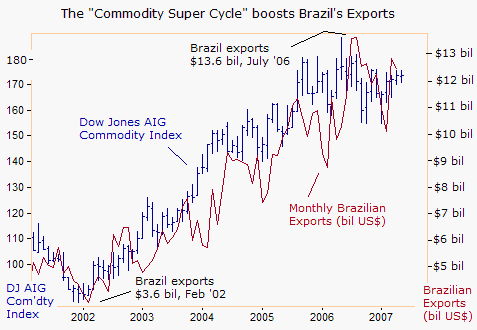
Besides iron ore, Brazil is blessed with other valuable minerals such as, chrome ore, copper, manganese, diamonds, gem stones, gold, nickel, tin, bauxite, uranium, platinum, and zinc. About a third of Brazil's economy is linked to agriculture, and it's the world's largest exporter of coffee, sugar, cattle, orange juice, and surpassed the US as the biggest exporter of soybeans in January 2006. The rain forests of the Amazon River basin produce timber, rubber, and other forest products such as Brazilian nuts and pharmaceutical plants.
The emergence of the “Commodity Super Cycle,” combined with a global economy expanding at an annualized 5% rate for the past four years, helped to lift Brazil's exports to a record $137 billion in 2006, with agricultural exports accounting for roughly 37% of foreign sales. Brazil's trade surplus expanded to $47 billion last year, up from $2.6 billion just 4 years earlier, and so far in the first four months of 2007, the trade surplus was $13 billion, or 4.3% higher than in the previous year.
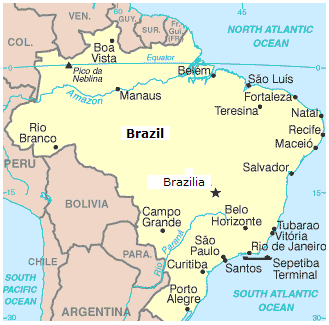
Ravenous Chinese demand for Brazilian soybeans has doubled since the turn of the century. Even so, 's agricultural potential has yet to be fully exploited. It's larger than the 's lower 48 states, and today grows crops on only 19% of its 790 million cultivable acres. also plans to build 73 new sugar mills between now and 2012, in order to raise its ethanol production. can make ethanol for about $1 a gallon, and expects ethanol exports to double to $1.3 billion in 2010, largely to and . 's Companhia Vale do Rio Doce (CVRD), the world's largest iron ore miner, has reserves estimated to last for 500 years.
But beneath the glossy export figures are some worrisome trends. Higher export prices accounted for 72% of the increase in Brazilian exports last year, while foreign sales volume increased by only 5.3%, much less than the 11.6% growth in 2005 and the 17.6% in 2004. The unrelenting strength of the Brazilian real is starting to cut into exporter earnings, and would become more troublesome for exporters if global commodity prices flatten out or move lower in 2007.
Bank of Brazil's defense of US dollar Disintegrates
Over the past 14-months, the Bank of Brazil (BoB) fought hard to prevent the real from appreciating against the currencies of its major trading partners in Europe (26% of trade) the (24%) and Asia (12%). Each day this year, the BoB intervened in the foreign currency market to mop-up the US dollars flowing into the country, and tried to put an artificial floor under the greenback at 2.10-reals.
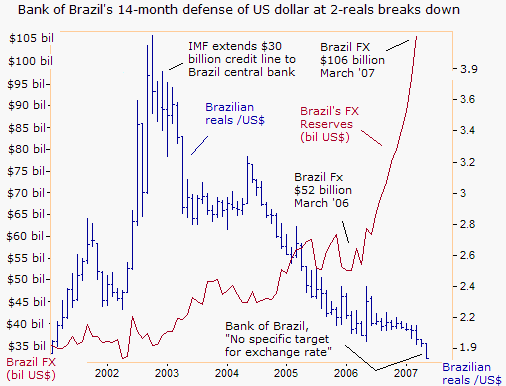
Brazil 's finance minister Guido Mantega said the central bank's foreign currency reserves soared to $120 billion in April, up from $52 billion in March 2006, during the bank's 14-month defense of the US dollar at 2.1-reals. On May 3 rd , the BoB stepped up its intervention in the market and offered about $3.1 billion of reverse currency swaps, compared with a weekly average of $600 million, and executed another $1 billion of swaps on May 16 th , but failed to halt the dollar's slide below 2.0-reals.
History Turned Upside-down
It's a 180 degree sea change from June 2002, when the Brazilian real had plunged to 2.84 against the dollar, and Brazil's 8% Brady bond due 2014, fell to three-year lows, to yield 21.1%, their highest level since 1995, shortly after Mexico devalued its peso. Traders were gripped with fear that 's leading presidential candidate, Luiz Inacio Lula da Silva, of the Socialist Workers' Party, wouldn't control spending nor pay-off the country's 929 billion reals ($382 billion) of debt.
To stop the bleeding in August 2002, the International Monetary Fund (IMF) provided Brazil's central bank with an emergency $30 billion credit line for intervention to stabilize the battered real. The IMF agreement allowed to spend an additional $10 billion of its foreign currency reserves to protect the real, which effectively gave $40 billion to avert an economic meltdown.
But on October 14, 2002, 's central bank was forced to jack-up its overnight Selic rate by 3% following an emergency policy meeting to 21%, citing worsening inflation sparked by the fall of the real. The Brazilian currency had lost more than 40% of its value against the dollar in the first 10 months of 2002. Banco Central de Brasil also raised bank reserve requirements to reduce the amount of reals in the financial system, but the currency still fell 1% to close lower at 3.85 per dollar.
Brazil becomes a Magnet for Global Hot Money
Today , traders are looking at with rose colored lenses, and its double-digit deposits rates of around 12.50%, are still acting as a powerful magnet for hot money flows from around the world. The Bank of Brazil has slashed its overnight Selic lending rate 15 consecutive times from a high of 19.75% in September 2005 to an all-time low of 12.5% on April 19 th , but hasn't been able to stop the dollar's slide .
Instead, global traders are snapping up many of the 50-companies listed in the blue-chip Bovespa stock index before Beijing goes on its buying spree for key assets in global markets. Traders can also buy 's benchmark zero-coupon bond due in January 2008, denominated in reals, and yielding a juicy 11.43 percent.
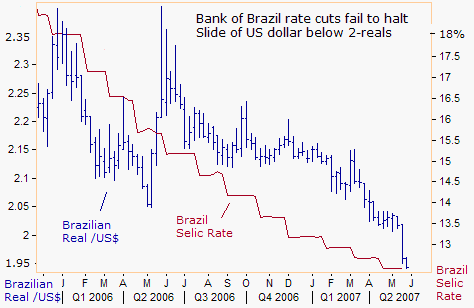
On May 15 th , Brazil's central bank chief Henrique Meirelles signaled a shift in its intervention tactics by conceding that, “The central bank has no target for the exchange rate. At the same time, the central bank won't allow prices to be distorted or move in ways unrelated to economic fundamentals,” he said. 's finance minister Guido Mantega also relented to a stronger real on April 27 th .
“The real's appreciation is almost inevitable and the biggest challenge today. Obviously, this causes losses for some economic sectors. We aren't going to artificially fix the currency issue. The country is very solid and, unfortunately or fortunately, this influences the currency,” Mantega said. Thus, is distancing itself from 's manhandling the dollar /yuan within a tight trading band.
Benefits of a Stronger Real outweigh the Costs
Although Brazil's exports could be hurt by a stronger real against its major trading partners this year, the losses could be mitigated if commodity prices stay high or climb higher, and if the global economy continues to expand at a 5% rate. The Brazilian economy could also receive a boost if South Korean car maker Hyundai opens up a new factory in the country to produce 100,000 vehicles per year.
In other areas, the benefits of a stronger real greatly outweigh the costs, by applying downward pressure on import prices and inflation, already among the lowest in Latin America . Consumer prices, as measured by the benchmark IPCA index, rose 2.96% in the 12 months through March, its lowest rate since February 1999, and compares with the central bank's inflation target of 4.5% for this year and into 2008.
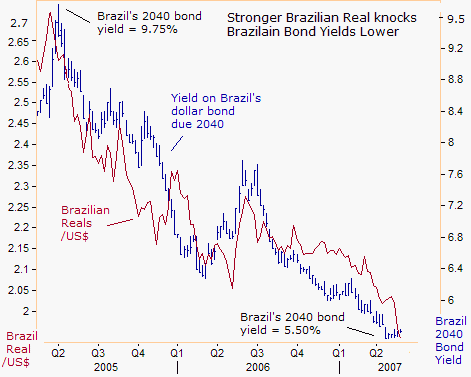
The stronger real and lower inflation pressures, led to an enormous drop in long-term government bond yields from a record high of 25.6% in September 2002 to as low as 5.60% today. The average yield spread on Brazilian government bonds traded in US$, over comparable US Treasuries, as measured by the JP Morgan Emerging Markets bond index fell to an all-time low of 138 basis points on May 20th.
The “Commodity Super Cycle” has boosted the foreign currency reserves of Latin American countries, allowing them to buy back dollar-denominated bonds and instead rely more on bond sales in local currencies to meet their financing needs. Emerging-market nations sold $37.4 billion of US dollar denominated debt in 2006, down from $47.7 billion in 2005. Merrill Lynch predicts bond sales will fall 32% this year to $25.4 billion, hardly enough to satisfy the demand of “yen carry” traders, who bought $18 billion of Brazilian debt last year.
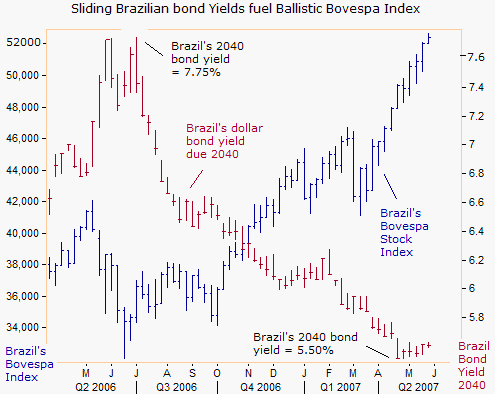
The yield on Brazil's dollar bond, due in 2040, fell to a record low of 5.50% last week, after Standard & Poor's boosted its sovereign credit rating to BB+ from BB, or one notch below investment grade. The long-term credit rating denominated in Brazilian reals was lifted by two notches to BBB from BB+. S&P also upgraded the country's short-term local currency sovereign credit rating to A- from single B.
“The efforts by the government to reduce vulnerability to interest rate and to foreign exchange rate fluctuations have been very positive,” said Standard & Poor's on May 16 th , referring to the central bank's massive build-up of foreign currency reserves. Thus, in a virtuous cycle of events, high commodity prices have boosted 's exports and trade surplus, which in turn, strengthened the real and allowed the central bank to build-up its foreign exchange reserves.
More foreign exchange on hand at the central bank improves 's ability to service its outstanding debt, which in turn, boosts its credit rating and lowers long-term bond yields. Coupled with an easier monetary policy and a 16% growth rate of the M3 money supply, it's no wonder that 's Bovespa index has gone ballistic.
By Gary Dorsch,
Editor, Global Money Trends newsletter
http://www.sirchartsalot.com
Here's what you will receive with a subscription, Insightful analysis and predictions for the (1) top dozen stock markets around the world, Exchange Traded Funds, and US home-builder indexes (2) Commodities such as crude oil, copper, gold, silver, the DJ Commodity Index, and gold mining and oil company indexes (3) Foreign currencies such as, the Australian dollar, British pound, Euro, Japanese yen, and Canadian dollar (4) Libor interest rates, global bond markets and central bank monetary policies, (5) Central banker "Jawboning" and Intervention techniques that move markets.
GMT filters important news and information into (1) bullet-point, easy to understand analysis, (2) featuring "Inter-Market Technical Analysis" that visually displays the dynamic inter-relationships between foreign currencies, commodities, interest rates and the stock markets from a dozen key countries around the world. Also included are (3) charts of key economic statistics of foreign countries that move markets.
A subscription to Global Money Trends is offered at only $140 US dollars per year for “44 weekly issues”, including access to all back issues. Click on the following hyperlink, to order now, http://www.sirchartsalot.com/newsletters.php Call toll free from USA to order, Sunday thru Thursday, 2 am to 4 pm EST, at 866-576-7872.
Mr Dorsch worked on the trading floor of the Chicago Mercantile Exchange for nine years as the chief Financial Futures Analyst for three clearing firms, Oppenheimer Rouse Futures Inc, GH Miller and Company, and a commodity fund at the LNS Financial Group.
As a transactional broker for Charles Schwab's Global Investment Services department, Mr Dorsch handled thousands of customer trades in 45 stock exchanges around the world, including Australia, Canada, Japan, Hong Kong, the Euro zone, London, Toronto, South Africa, Mexico, and New Zealand, and Canadian oil trusts, ADR's and Exchange Traded Funds.
He wrote a weekly newsletter from 2000 thru September 2005 called, "Foreign Currency Trends" for Charles Schwab's Global Investment department, featuring inter-market technical analysis, to understand the dynamic inter-relationships between the foreign exchange, global bond and stock markets, and key industrial commodities.
Copyright © 2005-2007 SirChartsAlot, Inc. All rights reserved.
Disclaimer: SirChartsAlot.com's analysis and insights are based upon data gathered by it from various sources believed to be reliable, complete and accurate. However, no guarantee is made by SirChartsAlot.com as to the reliability, completeness and accuracy of the data so analyzed. SirChartsAlot.com is in the business of gathering information, analyzing it and disseminating the analysis for informational and educational purposes only. SirChartsAlot.com attempts to analyze trends, not make recommendations. All statements and expressions are the opinion of SirChartsAlot.com and are not meant to be investment advice or solicitation or recommendation to establish market positions. Our opinions are subject to change without notice. SirChartsAlot.com strongly advises readers to conduct thorough research relevant to decisions and verify facts from various independent sources.
© 2005-2022 http://www.MarketOracle.co.uk - The Market Oracle is a FREE Daily Financial Markets Analysis & Forecasting online publication.


